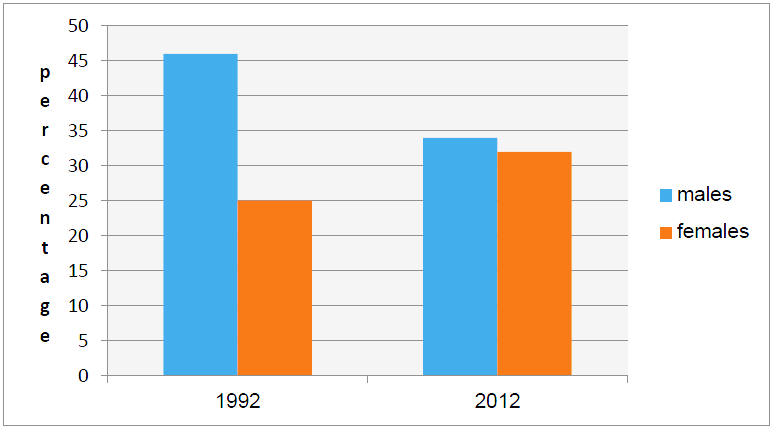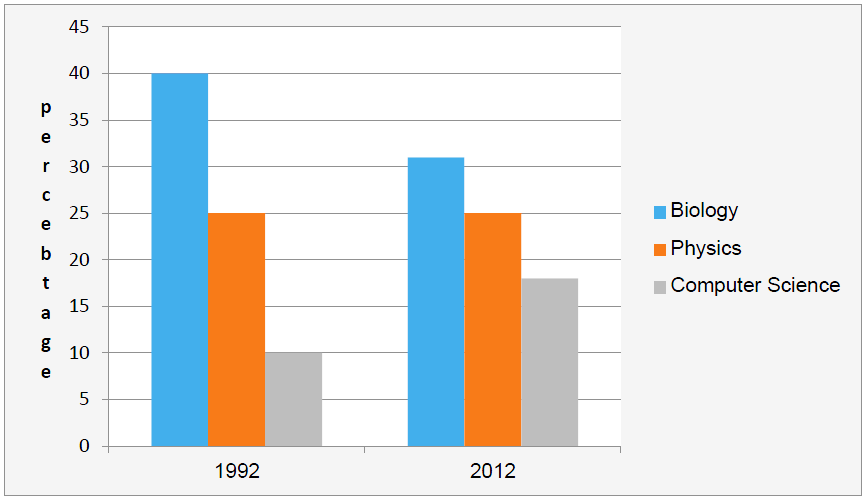ĐỀ WRITING NGÀY 7/9/2019
Task 1:
The charts show the percentage of male and female students choosing science subjects in one university in 1992 and 2012 and the three most popular science subjects which they studied.


Nhận xét: đề khá đơn giản, không có gì lắt léo phức tạp, chỉ cần so sánh các số, tìm trend tăng giảm qua 20 năm là được.
The bar charts illustrates the proportion of male and female undergraduates opting for science subjects in a university and their top three subjects of selection in 1992 and 2012.
As can be seen in the first bar graph, in 1992, the percentage of male students choosing to study science subjects was much higher than that of female students, with figures being almost 46% and 25% respectively. However, while the popularity of science subjects dropped drastically among male students in 2012 when only around 34% of them registered for these courses, the situation was opposite for females when their figure escalated to approximately 32% that year.
According to the second bar graph, biology always topped the list of favourate subjects among students at the university in both years with figures dropping from 40% in 1992 to about 32% in 2012. Meanwhile numbers remained unchanged at 25% for physics and lifted from 10% to about 18% for the least popular subject of computer science over the period.
Overall, throughout the period, male students predominated registration for science courses, and the drop in popularity of biology seemed to have the same magnitude as the rise in selection of computer science. (197 words)
Task 2:
Increases in the production of consumer goods results in damage to the natural environment. Why is this the case? What can be done to solve this problem?
Outline:
Why producing more consumer goods harm the natural environment?
- Increase in production: more materials, fuel needed à depletion of natural resources à cause scarcity of fossil fuels, overlogging for wood,
- more waste produced in the production process (greenhouse gases, sewage, solid waste)
- inundate supply of consumer goods flooding markets à practice a wasteful lifestyle of consumers à worsen the vicious circle of increasing production and harming the environment.
What can be done to counteract the damage?
- promote simple lifestyle in society (examples of movie stars and billionaires leading a frugal lives and use money for charity purposes should be highlighted to set examples for society.
- Raise awareness of people about how environmentally damaging excessive shopping is à gives them reason to hold themselves back before the temptation of grabbing more for their shopping carts.
- Apply environmental tax for products especially those that are resource-consuming and environmentally-hostile.
Vocabulary:
profit margin : (n) lợi nhuận biên
bulk shopping : (n) mua số nhiều
utilization: (n) việc sử dụng
imminent depletion : (n) sự cạn kiệt sắp đến
exploitation: (n) sự khai thác, bóc lột
increasing scarcity : (n) ngày càng khan hiếm
overlogging : (n) khai thác gỗ quá mức
soil degradation : (n) thoái hóa đất
intensive farming : (n) thâm canh
abundant supply : (n) sự cung cấp dư thừa
vicious circle : (n) cái vòng lẩn quẩn
publicity : (n) sự xuất bản
lead a frugal life : (v) sống tiết kiệm
influencers : (n) người có tầm ảnh hưởng lớn
excessive shopping : (n) mua sắm quá nhiều
resist the temptation : (v) chống lại cám dỗ
deprivation : (n) sự tước đoạt
at hand: (prep) sẵn có
tariff: (n) thuế
The essay:
Manufacturers constantly try to cut cost and improve their profit margin by boosting massive production and encouraging bulk shopping of consumer products. This harms the environment in many ways, but definitely there are solutions to the problem.
The reasons behind environmental damages cause by producing more consumer goods lie in the massive utilization of natural resources and the shopping habits of people. First, the increase in production of consumer goods requires greater supply of materials and fuel, which leads to the imminent depletion of natural resources. This exploitation causes the increasing scarcity of such materials as metal, rare earth, and fossil fuels together with other environmental problems like deforestation due to over-logging, or soil degradation due to intensive farming for industrial crops. Second, more manufacturing activities produce more wastes like greenhouse gases, sewage and solid waste which causes global warming and a wide range of pollution for the air, water, and soil. Third, abundant supplies of consumer goods to markets encourages the wasteful lifestyle of consumers, which worsens the vicious circle of increasing production and harming the environment.
However, solutions are plentiful for counteracting the environmental damages resulted from increasing production of consumer goods. First, societies need to promote simple lifestyles through the publicity of examples of movie stars and billionaires leading frugal lives. These influencers have great power in shaping social opinions and thus can be brilliant examples for society to follow. Second, awareness of people should be raised through media campaigns about how environmentally damaging excessive shopping is. Watching short clips about consequences of the wasteful consumption somehow will give shoppers reasons to resist the temptation of grabbing more for their shopping carts. Third, applying environmental tax for products especially those that are resource-consuming and environmentally unfriendly can be a direct blow to the habit of over-shopping. When demand loses heat, so will the supply, production, and their problems.
In conclusion, the deprivation of the natural world with the exploitation of its resources and the emission of contaminants for increasing production of consumer goods is palpable, but solutions to this challenge is also at hand with the participation of the media and the government in forming environmentally-friendly lifestyles and adjusting consumer behaviors by environmental tariff. (367 words)
